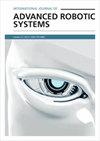利用拍摄距离未知照片进行基于扩展照片模型的立体视觉姿势估计
IF 2.1
4区 计算机科学
Q2 Computer Science
International Journal of Advanced Robotic Systems
Pub Date : 2024-01-01
DOI:10.1177/17298806231218789
引用次数: 0
摘要
基于模型的立体视觉姿势估计取决于模型的建立。基于照片模型的方法简化了建立模型的过程,只需一张照片。编程语言不会预先定义物体的形状、颜色和图案。然而,过去需要根据照片的拍摄距离计算像素/公制比,即物体每毫米的像素数,以生成与实际物体大小(长和宽)相同的照片模型。这限制了实际应用。建议的方法扩展了传统的照片建模算法,放宽了确定目标姿态的照片前提条件。将假设不同的像素/度量比来生成不同尺寸的三维照片模型。这些模型将用于立体视觉图像匹配技术,以检测目标物体的姿态。由于这不是一种数据驱动的方法,因此不需要很多图片和预训练时间。本文将该算法应用于海港和水产养殖业的清洁工作,目的是在采集前定位水面上死亡或患病的海洋生物。在实际应用场景中进行了姿态估计实验,以检测物体的姿态和准备好的照片的像素/度量比。结果表明,扩展照片模型立体视觉方法可以用一张像素/度数比未知照片估计出目标的姿态。本文章由计算机程序翻译,如有差异,请以英文原文为准。
Expanded photo-model-based stereo vision pose estimation using a shooting distance unknown photo
Model-based stereo vision pose estimation depends on the establishment of the model. The photo-model-based method simplifies the model-building process with just one photo. Programming languages do not predefine the shapes, colors, and patterns of objects. In the past, however, it was necessary to calculate a pixel per metric ratio, that is, the number of pixels per millimeter of the object, based on the photo’s shooting distance to generate a photo-model with the same size (length and width) as the actual object. It restricts the real application. The proposed method extends the traditional photo-modeling algorithm and relaxes the photo prerequisite for target pose determination. Various pixel per metric ratios will be assumed to generate 3D photo-models of different sizes. These models will then be employed in stereo vision image matching techniques to detect the pose of the target object. Since it is not a data-driven method, it does not require many pictures and pretraining time. This article applies the algorithm to the cleaning of seaports and aquaculture, aiming to locate dead or diseased marine life on the water surface before collection. Pose estimation experiments have been conducted to detect an object’s pose and a prepared photo’s pixel per metric ratio in real application scenarios. The results show that the expanded photo-model stereo vision method can estimate the pose of a target with one pixel per metric ratio unknown photo.
求助全文
通过发布文献求助,成功后即可免费获取论文全文。
去求助
来源期刊
CiteScore
6.50
自引率
0.00%
发文量
65
审稿时长
6 months
期刊介绍:
International Journal of Advanced Robotic Systems (IJARS) is a JCR ranked, peer-reviewed open access journal covering the full spectrum of robotics research. The journal is addressed to both practicing professionals and researchers in the field of robotics and its specialty areas. IJARS features fourteen topic areas each headed by a Topic Editor-in-Chief, integrating all aspects of research in robotics under the journal''s domain.

 求助内容:
求助内容: 应助结果提醒方式:
应助结果提醒方式:


